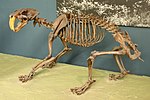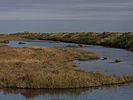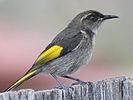| << | Today's featured articles for January 2017 | >> | ||||
|---|---|---|---|---|---|---|
| Su | Mo | Tu | We | Th | Fr | Sa |
| 1 | 2 | 3 | 4 | 5 | 6 | 7 |
| 8 | 9 | 10 | 11 | 12 | 13 | 14 |
| 15 | 16 | 17 | 18 | 19 | 20 | 21 |
| 22 | 23 | 24 | 25 | 26 | 27 | 28 |
| 29 | 30 | 31 | ||||
January 1
Madman's Drum is a 1930 wordless novel by American artist Lynd Ward (1905–1985). Its 118 images tell the story of a slave trader who steals a demon-faced drum from an African he murders, and of the consequences for him and his family. The book was executed in wood engravings. It is the second of Ward's six wordless novels, after Gods' Man of 1929. Ward was more ambitious with this second work in the medium: the characters are more nuanced, the plot more developed and complicated, and his outrage at social injustice more explicit. He used a finer degree of detail in the artwork, through a wider variety of carving tools, and was expressive in his use of symbolism and exaggerated emotional facial expressions. The success of Ward's first two wordless novels encouraged publishers to issue more books in the genre. In 1943 psychologist Henry Murray used two images from the work in his Thematic Apperception Test of personality traits. Madman's Drum is considered less successfully executed than Gods' Man, and Ward streamlined his work in his next wordless novel, Wild Pilgrimage (1932). (Full article...)
January 2
The English Benedictine Reform in the late tenth century was the most important religious and intellectual movement in the later Anglo-Saxon period. The reformers sought to replace married secular clergy in monasteries with celibate contemplative monks who followed the Rule of Saint Benedict. The court of Æthelstan (924–939), the first king of the whole of England, began a cosmopolitan trend; future reformers such as Æthelwold of Winchester, Oswald of Worcester, and Dunstan, Archbishop of Canterbury, learned from Continental exponents of Benedictine monasticism. The reformers had close relations with the crown, furthering its interests and depending on its support, especially under King Edgar (959–975). Influential artistic workshops established by Æthelwold reached a high standard of craftsmanship in manuscript illustration, sculpture and gold and silver, and his monasteries produced scholarship and competent prose and poetry in the elaborate hermeneutic style of Latin. His Winchester school helped create the standard vernacular West Saxon literary language, and his pupil Ælfric was its most eminent writer. (Full article...)
January 3
Smilodon is an extinct genus of saber-toothed cats that lived in the Americas between 2.5 million and 10,000 years ago, during the Pleistocene epoch. It was named in 1842 and identified by fossils from Brazil. The largest collection of its fossils has come from the La Brea Tar Pits in Los Angeles, California. The species S. gracilis and S. fatalis lived mostly in North America. A third species, the South American S. populator (meaning destroyer), was perhaps the largest known member of the family of cats, at 220 to 400 kg (490 to 880 lb) and 120 cm (47 in) in height. Overall, saber-toothed tigers were stronger than any modern cat, with well-developed forelimbs, big jaws, and long, slender upper canines, adapted for precision killing. In North America, they hunted large herbivores such as bison and camels, pinning their prey before biting it. They probably lived in habitats that provided cover for ambushing prey, such as forests and shrubland. They died out at the same time that most North and South American megafauna disappeared, during a period of climate change about 10,000 years ago. (Full article...)
January 4
Wrestle Kingdom 9 was a professional wrestling event at the Tokyo Dome on January 4, 2015, produced by the New Japan Pro Wrestling (NJPW) promotion. The first event on the 2015 NJPW schedule, it featured ten professional wrestling matches and one pre-show match, six of which were for championships. In the double main event, Shinsuke Nakamura successfully defended the IWGP Intercontinental Championship (belt pictured) against Kota Ibushi, and Hiroshi Tanahashi successfully defended the IWGP Heavyweight Championship against Kazuchika Okada. The appearance of Pro Wrestling Noah wrestlers led to a storyline in which NJPW's Suzuki-gun group began wrestling at Noah events. Wrestle Kingdom 9 was attended by 36,000 people and was broadcast as a pay-per-view event with English commentary in the United States and Canada. Critics issued universally positive reviews; Paste magazine said it presented "some of the most passionate and poignant performance art today". Readers of the Wrestling Observer Newsletter voted Wrestle Kingdom 9 the Best Major Wrestling Show of 2015, and named its Ibushi–Nakamura match as the 2015 Pro Wrestling Match of the Year. (Full article...)
January 5
Defense of the Ancients (DotA) is a multiplayer online battle arena mod, or game modification, created for the video game Warcraft III: Reign of Chaos and its expansion, Warcraft III: The Frozen Throne. First released in 2003, it is based on StarCraft custom map "Aeon of Strife". Each team of up to five players attempts to destroy the opponents' Ancient, a heavily guarded structure at a far corner of the map. Players use powerful units known as heroes, and are assisted by allied heroes and AI-controlled fighters. As in role-playing games, players level up their heroes and use gold to buy items and equipment during the game. DotA became a feature at several worldwide tournaments, including Blizzard Entertainment's BlizzCon, and was featured at the Asian World Cyber Games and in the Cyberathlete Amateur League. Valve Corporation acquired the intellectual property rights to DotA to develop a stand-alone sequel, Dota 2, released in July 2013. (Full article...)
January 6
The Clinton Engineer Works was the site of the Manhattan Project's World War II production facilities that provided the enriched uranium used in the bombing of Hiroshima in August 1945. Its X-10 Graphite Reactor produced the first samples of plutonium from a reactor. Located just south of the town of Clinton, Tennessee, it included the production facilities of the K-25, Y-12 and S-50 projects, various utilities, and the township of Oak Ridge. The Manhattan District Engineer, Kenneth Nichols, moved the Manhattan District headquarters there from Manhattan in August 1943. Many construction workers were housed in large temporary communities, including Happy Valley. The construction labor force peaked at 75,000. Oak Ridge was established to house the operating staff, which peaked at 50,000 workers just after the war. It was developed by the federal government as a segregated community; black residents lived in an area known as Gamble Valley, in government-built hutments of one-room shacks. (Full article...)
January 7
Francis Poulenc (7 January 1899 – 30 January 1963) was a French composer and pianist. His compositions include mélodies, solo piano works, chamber music, choral pieces, operas, ballets, and orchestral concert music. Among his frequently performed pieces are the piano suite Trois mouvements perpétuels (1919), the ballet Les biches (1923), the Concert champêtre (1928) for harpsichord and orchestra, the opera Dialogues des Carmélites (1957), and the Gloria (1959) for soprano, choir and orchestra. Largely self-educated musically, he studied with the pianist Ricardo Viñes and was influenced by the avant-garde composer Erik Satie. Initially composing light-hearted and irreverent works, he also wrote serious, sombre and religious pieces beginning in the 1930s. He was an accomplished pianist, and toured Europe and America performing with the baritone Pierre Bernac and the soprano Denise Duval. One of the first composers to see the importance of the gramophone, he recorded extensively from 1928 onwards. This century has seen many new productions worldwide of his serious works, including Dialogues des Carmélites and La Voix humaine. (Full article...)
January 8
Operation Ironside was a deception operation in the Second World War, meant to persuade the Germans that the Allies would stage an invasion near Bordeaux along the Bay of Biscay. The operation consisted entirely of deceptive messages, without any supporting physical evidence, unlike other deception operations intended to draw German defences away from the planned Normandy landings. Bordeaux was an important military port during the war and had already been a target of commando raids in 1942. Planned by the London Controlling Section, Ironside was communicated to the Germans by double agents in May and June 1944. Rumours of an impending two-division assault were communicated by Agent Bronx, a Peruvian socialite, with help from other agents, including Tate and Garbo. Historians have found no indication that the Germans believed an invasion in the area to be imminent, probably because Bordeaux was beyond air cover from the UK and there were no detectable naval activities in the region. Nevertheless, the operation may have succeeded in delaying one Panzer division from moving north to defend in Normandy. (Full article...)
January 9
The Rogue River in southwestern Oregon in the United States flows 215 miles (346 km) generally westward, from the Cascade Range to the Pacific Ocean. With salmon runs, whitewater rafting, and rugged scenery, it was one of the original eight rivers designated for protection by the Wild and Scenic Rivers Act of 1968. Beginning near Crater Lake, which occupies the caldera left by the explosive volcanic eruption of Mount Mazama, the river flows through the geologically young High Cascades, the older Western Cascades, and the ancient Klamath Mountains. The Kalmiopsis Wilderness section of the Rogue basin contains peridotite rocks from the Earth's mantle. Near the mouth of the river, dinosaur fragments were found in the Otter Point Formation. European explorers made first contact with local Native Americans toward the end of the 18th century and began beaver trapping. Clashes between the natives and the trappers and later between the natives and European-American miners and settlers culminated with the Rogue River Wars of 1855 and 1856. (Full article...)
January 10
Kalki Koechlin (born 10 January 1984) is an Indian actress and writer of French descent who predominantly works in Bollywood. After studying drama at Goldsmiths, University of London, she made her screen debut in the drama Dev.D in 2009, winning a Filmfare Award for Best Supporting Actress. She starred in and co-wrote the screenplay for the crime thriller That Girl in Yellow Boots (2011). She has starred in two top-grossing films, the coming-of-age film Zindagi Na Milegi Dobara (2011) and the romantic drama Yeh Jawaani Hai Deewani (2013). Her work in the independent drama Margarita with a Straw (2014) earned a National Film Award – Special Jury Award. Her commercially successful films include the political drama Shanghai (2012) and the supernatural thriller Ek Thi Daayan (2013). She won The MetroPlus Playwright Award for co-writing the dramatic play Skeleton Woman (2009), and made her directorial debut on stage with the tragicomedy Living Room (2015). She hosted a travel show entitled Kalki's Great Escape in 2016. Koechlin promotes causes ranging from health and education to women's empowerment and gender equality. (Full article...)
January 11
Dover Athletic Football Club is an association football club formed in 1983, based in the town of Dover, Kent, England. In the 1989–90 season Dover Athletic won the Southern League championship, but failed to gain promotion to the Football Conference as the club's ground did not meet the required standard. Three seasons later the team won the title again and this time gained promotion to the Conference, where they spent nine seasons before being relegated. The club was transferred to the Isthmian League Premier Division in 2004, but another poor season led the club to a further relegation. After three seasons in the Isthmian League Division One South, the club won the championship and promotion back to the Premier Division, and the following season won another championship and promotion to Conference South. In the 2013–14 season, Dover defeated Ebbsfleet United to return to the Conference Premier after a twelve-year absence. Nicknamed the Whites for their white shirts, they have played at the Crabble Athletic Ground since the club's formation. Their best performance in the FA Cup was reaching the third round proper in both the 2010–11 and 2014–15 seasons. (Full article...)
January 12
The Monster is an 1898 novella by American author Stephen Crane (1871–1900), a study of prejudice, fear and isolation in a small town. In the fictional Whilomville, New York, an African-American coachman named Henry Johnson, who is employed by the town's physician, Dr. Trescott, becomes horribly disfigured after he saves Trescott's son from a fire. When Henry is branded a "monster" by the town's residents, Trescott vows to shelter and care for him, resulting in his family's exclusion from the community. Whilomville, which is used in 14 other Crane stories, was based on Port Jervis, New York, where he spent part of his youth. He probably took inspiration from several local men who were similarly disfigured. Modern critics have connected themes of racial division in the story to the 1892 lynching in Port Jervis of an African-American man named Robert Lewis. The novella was included in The Monster and Other Stories—the last collection of Crane's work to be published during his lifetime. Both the novella and the collection received mixed reviews from critics, but The Monster is now considered one of Crane's best works. (Full article...)
January 13

The Jersey Act was a 1913 regulation by the British Jockey Club and the owners of the General Stud Book that prevented most American-bred Thoroughbred horses from registering with them. It was intended to halt the increasing importation of racehorses of possibly impure bloodlines after a series of bans on gambling by US states, including gambling on horse races. The loss of breeding records during the American Civil War and the late beginning of the registration of American Thoroughbreds led many in the British racing establishment to doubt that the American-bred horses were purebred. The Act prohibited the registration of horses unless all of their Thoroughbred ancestors had been registered. Despite protests from American breeders the regulation was in force until 1949. By then, ineligible horses were increasingly successful in races in Europe, British and Irish breeders had lost access to French Thoroughbreds during and after the Second World War, and any impure ancestors of the American bloodlines had receded far back in most horses' ancestry. (Full article...)
January 14
Interstate 275 (I-275) in the US state of Michigan is a western bypass around the Detroit metropolitan area, completed on January 14, 1977. The freeway is maintained by the Michigan Department of Transportation as part of the larger state trunkline highway system. It runs through the western suburbs near Detroit Metropolitan Wayne County Airport, terminating in an interchange with I-75 near Newport, northeast of Monroe. Early planning maps for the Interstate Highway System in the 1950s included a highway roughly parallel to the modern I-275. As plans developed through the 1960s and into the early 1970s, the freeway was to run from I-75 near Newport north to Novi and connect back to I-75 near Davisburg, but the state canceled the northern section after local opposition. Additional plans to extend the highway through Oakland County were kept on the drawing boards through the 1980s, but failed to materialize. Highway M-5, the Haggerty Connector, opened along part of the former I-275/M-275 right-of-way between 1994 and 2000. (Full article...)
January 15
The Pale Emperor is the ninth studio album by American rock band Marilyn Manson, released on January 15, 2015. In place of their usual industrial rock style, the album features a sparser, blues-rock-influenced sound. It was the band's first album to be co-produced by score composer Tyler Bates, who had met frontman Marilyn Manson (pictured) through their mutual involvement in the television series Californication. It was released through the singer's Hell, etc. label to generally positive reviews, with several publications referring to it as the band's best album in over a decade. It went on to appear on multiple best-album lists for 2015. It was also a commercial success, debuting at number eight on the Billboard 200 with the band's highest opening week sales since 2007. The album was dedicated to Manson's mother, who died of Alzheimer's disease during its production. To promote the record, the band embarked on The Hell Not Hallelujah Tour, which ran for almost two years along with two co-headlining tours: The End Times with The Smashing Pumpkins, and a summer 2016 tour with Slipknot. (Full article...)
January 16
Night of January 16th is a play by Russian-American author Ayn Rand, inspired by the death of Ivar Kreuger, an industrialist and accused swindler known as the Match King. The play is set in a courtroom during a murder trial, and members of the audience are chosen to play the jury. The court hears the case of Karen Andre, a former secretary and lover of businessman Bjorn Faulkner, of whose murder she is accused. The jury must rely on character testimony to decide whether Andre is guilty; the play's ending depends on their verdict. Rand wanted to dramatize a conflict between individualism and conformity. The play was first produced in 1934 in Los Angeles under the title Woman on Trial. Producer Al Woods took it to Broadway for the 1935–36 season and re-titled it Night of January 16th. It became a hit and ran for seven months. The play has been adapted as a movie, as well as for television and radio. Rand had many disputes with Woods over the play, and in 1968 re-edited it for publication as her "definitive" version. (Full article...)
January 17
The Dorset Ooser is a wooden head that featured in the nineteenth-century folk culture of Melbury Osmond, a village in the southwestern English county of Dorset. The head was hollow, thus perhaps serving as a mask, and included a humanoid face with horns, a beard, and a hinged jaw. Although sometimes used to scare people during practical jokes, its main recorded purpose was as part of a local variant of the custom known as "rough music", in which it was used to humiliate those who were deemed to have behaved in an immoral manner. It was first brought to public attention in 1891, when it was owned by the Cave family of Melbury Osmond's Holt Farm, but it went missing around 1897. In 1975 a replica of the original Ooser was produced by John Byfleet, which has since been on display at Dorset County Museum in Dorchester. This mask retains a place in Dorset folk culture, and is used in local Morris dancing processions held by the Wessex Morris Men on Saint George's Day and May Day. The design of the Ooser has inspired copies used as representations of the Horned God in the modern Pagan religion of Wicca in both the United Kingdom and United States. (Full article...)
January 18

Sesame Street international co-productions are educational children's television series based on the American Sesame Street but tailored to the countries in which they are produced. Shortly after the debut of Sesame Street in the US in 1969, television producers, teachers, and officials of several countries approached the show's producers and the executives of Children's Television Workshop (CTW) about the possibility of airing international versions of the show. Creator Joan Ganz Cooney hired former CBS executive Mike Dann to field offers to produce versions of the show in other countries, with original sets, characters, and curriculum goals. CTW's new shows included both dubbed versions of the American show and versions created, developed, and produced to reflect each country's needs, educational priorities, and culture. For example, the first HIV-positive Muppet, Kami, from the South African co-production Takalani Sesame, was created in 2003 to address the epidemic of AIDS. In 2001, there were more than 120 million viewers of all international versions of Sesame Street, and by the US show's 40th anniversary in 2009, they were being seen in more than 140 countries. (Full article...)
January 19
Hope is an 1886 Symbolist oil painting by the English artist George Frederic Watts. Radically different from previous treatments of the subject, it shows a lone blindfolded female figure sitting on a globe, playing a lyre which has only a single string remaining. Watts intentionally used symbolism not traditionally associated with hope to make the painting's meaning ambiguous. As reproductions began to circulate in large quantities worldwide, it became a widely popular image. Theodore Roosevelt displayed a copy at his Sagamore Hill home in New York, and a 1922 film was based on the painting. Although Watts was rapidly falling out of fashion by this time and Hope was increasingly seen as outdated and sentimental, it remained influential. Martin Luther King Jr. based a 1959 sermon on the theme of the painting, as did Jeremiah Wright in 1990. Among the congregation for the latter was the young Barack Obama, who took "The Audacity of Hope" as the theme of his 2004 Democratic National Convention keynote address, and as the title of his 2006 book; he based his successful 2008 presidential campaign around the theme of "Hope". (Full article...)
January 20
The impala (Aepyceros melampus) is a medium-sized antelope in eastern and southern Africa. First described by German zoologist Hinrich Lichtenstein in 1812, it reaches 70–92 centimetres (28–36 inches) at the shoulder, weighs 40–76 kilograms (88–168 pounds), and has a glossy, reddish brown coat. The male's slender, lyre-shaped horns can reach 45–92 centimetres (18–36 in), measured along the curve. Active mainly during the day, the impala may be gregarious or territorial. Three distinct social groups can be observed – the territorial males, bachelor herds and female herds. Browsers as well as grazers, impala feed on monocots, dicots, forbs, fruits and acacia pods. An annual, three-week-long rut takes place toward the end of the wet season, typically in May, and gestation lasts six to seven months. Calves are suckled for four to six months. The impala is found close to water, in woodlands and sometimes at the interface between woodlands and savannahs. The common impala is widespread across its range and has been reintroduced in Gabon and southern Africa, but the black-faced subspecies has been classified as a vulnerable species. (Full article...)
January 21
Muhammad ibn Tughj al-Ikhshid (882–946) was an Abbasid commander who became the ruler of Egypt and parts of Syria from 935 until his death. His Ikhshidid dynasty ruled until the Fatimid conquest of 969. In his turbulent early career, he was imprisoned along with his father Tughj ibn Juff by the Abbasids in 905, participated in the murder of the vizier al-Abbas ibn al-Hasan al-Jarjara'i in 908, and fled Iraq to enter the service of the governor of Egypt, Takin al-Khazari. He became governor himself, and quickly defeated a Fatimid invasion. His reign marks a rare period of peace and good government for early Islamic Egypt. He vied with other regional strongmen for control over Syria, without which Egypt was vulnerable to invasion from the east, but unlike many other Egyptian leaders, he was prepared to bide his time and compromise with his rivals. In 944 he received recognition of his hereditary rule over Egypt, Syria and the Hejaz for thirty years from Caliph al-Muttaqi of Baghdad. Ibn Tughj's son Unujur succeeded him, under the guardianship of the powerful Ethiopian eunuch Abu al-Misk Kafur. (Full article...)
January 22
In Australian service, Lockheed C-130 Hercules transport aircraft have been operated by the Royal Australian Air Force (RAAF). A total of forty-eight of the aircraft have served the RAAF since 1958, when No. 36 Squadron began replacing its Douglas C-47 Dakotas, and the C-130J model is still in Australian service today. As the RAAF's first strategic airlifters, the aircraft have frequently been used to deliver disaster relief in Australia and the Pacific region, as well as to support military deployments overseas. They saw extensive service during the Vietnam War, transporting troops and cargo to South East Asia and undertaking aeromedical evacuation. Nineteen of the RAAF's fleet of twenty-four C-130s took part in relief efforts in 1974–75 after Cyclone Tracy struck Darwin. Since then, the aircraft have been involved in humanitarian missions to New Guinea, Ethiopia, Rwanda, Cambodia, Bali, Sumatra, and New Zealand. They have also seen service during the Iranian Revolution in 1979, the Fijian coups in 1987, operations in Somalia in 1993, INTERFET operations in East Timor in 1999–2000, and beginning in 2001, the wars in Afghanistan and Iraq. (Full article...)
January 23
Jochen Rindt (1942–1970) became the only racing driver to be posthumously awarded the Formula One World Drivers' Championship after his death during the 1970 racing season. His debut in Formula One came in 1964 at the Austrian Grand Prix. He began racing for Cooper in 1965, then moved to Brabham for 1968 and Lotus in 1969. It was at Lotus that Rindt found a competitive car, although he had concerns about its safety. He won his first Formula One race at the 1969 United States Grand Prix. He had a very successful 1970 season, winning five of the first nine races, mainly in the revolutionary Lotus 72. In practice for the Italian Grand Prix, he spun into the guardrails after a failure on his brake shaft, and died from throat injuries. Overall, he competed in 62 Grand Prix races, winning 6 and achieving 13 podium finishes. He was also successful in sports car racing, winning the 1965 24 Hours of Le Mans paired with Masten Gregory in a Ferrari 250LM. Rindt was a popular figure in Austria and his success increased interest there in motorsport, and Formula One in particular. (Full article...)
January 24
In Our Time is Ernest Hemingway's first American collection of short stories, published in 1925 by Boni & Liveright. Its title is derived from "Give peace in our time, O Lord" from the English Book of Common Prayer. Hemingway first used the title for a collection of six nonfiction vignettes of 75 to 187 words, commissioned by Ezra Pound for The Little Review. He added 12 more vignettes for in our time (with lower-case title), published in 1924 in Paris, about matadors, the Battle of Mons, the Greco-Turkish War and the execution of six Greek cabinet ministers. The 1925 New York collection combined these and fourteen newly written short stories, including "Indian Camp" and "Big Two-Hearted River", two of his best-known Nick Adams stories. He added "On the Quai at Smyrna" for the 1930 edition. The collection resonates with themes of alienation, loss, grief and separation, and includes descriptions of war, bullfighting and current events. It is the earliest Hemingway work to employ his iceberg theory of writing, in which the underlying meaning is hinted at, rather than explicitly stated. The volume attracted attention from reviewers and is an important work in his canon. (Full article...).
January 25
"She Shoulda Said 'No'!" is a 1949 exploitation film in the spirit of morality tales such as the 1936 films Reefer Madness and Marihuana. Directed by Sam Newfield (listed as Sherman Scott) and starring Lila Leeds, it was inspired by the 1948 arrest of movie stars Robert Mitchum and Leeds for marijuana possession. The actors, along with two others, were arrested after smoking marijuana at Leeds' home and were charged with the felony of narcotics possession. Mitchum served time, but his conviction was overturned in 1951; Leeds served sixty days in prison, and after her release found no work in Hollywood until she was cast in this film. The film was issued under many titles and struggled to find a distributor until film presenter Kroger Babb reissued it as The Story of Lila Leeds and Her Exposé of the Marijuana Racket. It failed to achieve success under that title, and Babb eventually changed it to "She Shoulda Said 'No'!" (Full article...)
January 26
Ferugliotheriidae is one of three known families in the order Gondwanatheria, an enigmatic group of extinct mammals. Ferugliotheriids coexisted with dinosaurs, mainly during the Late Cretaceous epoch (84–66 million years ago) in Argentina, where they may have lived in a marshy or seashore environment. Genera in the family, including Trapalcotherium and Argentodites, are known from isolated low-crowned teeth and possibly a fragment of a lower jaw. The best-known representative of the family is Ferugliotherium windhauseni, a small mammal, around 70 g (2.5 oz), which may have eaten insects and plants. Ferugliotheriid incisors are long and procumbent and contain a band of enamel on only part of the tooth. The jaw fragment contains a long tooth socket for the incisor and bears a bladelike fourth lower premolar, resembling those of multituberculates. Low-crowned and bladelike teeth as seen in ferugliotheriids may have been evolutionary precursors of the high-crowned teeth of the family Sudamericidae. (Full article...)
January 27

The new wave of British heavy metal began in the late 1970s and achieved international attention by the early 1980s. Encompassing diverse mainstream and underground styles, the music often infused 1970s heavy metal music with the intensity of punk rock to produce fast and aggressive songs. The do-it-yourself ethic of the new metal bands led to the spread of raw-sounding, self-produced recordings and a proliferation of independent record labels. Song lyrics were usually about escapist themes from mythology, fantasy, horror or the rock lifestyle. The movement involved mostly young, white, male musicians and fans of the heavy metal subculture, whose behavioural and visual codes were quickly adopted by metal fans worldwide after the spread of the music to continental Europe, North America and Japan. The movement spawned perhaps a thousand bands, but only a few survived the rise of MTV and glam metal. Among them, Motörhead and Saxon had considerable success, and Iron Maiden and Def Leppard became international stars. (Full article...)
January 28
Thomas Carmichael Hindman, Jr. (January 28, 1828 – September 27, 1868) was a United States Representative from Arkansas before serving as a major general in the Confederate States Army during the American Civil War. During the Mexican–American War, he became a captain of his company. He was a member of the Mississippi House of Representatives from 1854 to 1856, and a Democratic representative in the Thirty-sixth Congress from 1859 to 1861. Despite being re-elected, he declined to serve after Arkansas seceded from the Union. Instead, Hindman joined the armed forces of the Confederacy. He was promoted to brigadier general in September 1861 and to major general the following April. He commanded the Trans-Mississippi Department, and later raised and commanded "Hindman's legion". After the war, he avoided surrender to the federal government by fleeing to Mexico City. He worked in Mexico as a coffee planter, and attempted to practice law. After returning to Arkansas, Hindman was murdered at his home by an unknown assailant in 1868. (Full article...)
January 29
Titchwell Marsh is an English nature reserve owned and managed by the Royal Society for the Protection of Birds. Its 171 hectares (420 acres) on the north coast of Norfolk, about 8 km (5.0 mi) east of the seaside resort of Hunstanton, include reed beds, saltmarshes, a freshwater lagoon, a sandy beach, and woodland. The reserve is important for some scarce breeding birds, such as pied avocets on the islands, and western marsh harriers, Eurasian bitterns and bearded reedlings in the reeds. It has regularly attracted rarities, as its location is important for migrating birds, and shelters the endangered European water vole. Facilities include three bird hides, a seawatching platform, two nature trails, and a visitor centre. In 2010 and 2011 the banks around the freshwater lagoon were improved and the brackish lagoon was converted to tidal saltmarsh (pictured), a more effective barrier to encroachment by the sea. Titchwell Marsh is archaeologically significant, with artefacts dating to the Upper Paleolithic, and has remains of military constructions from both world wars. (Full article...)
January 30
The crescent honeyeater (Phylidonyris pyrrhopterus) is a bird native to southeastern Australia, in the honeyeater family. It has dark grey plumage and paler underparts highlighted by yellow wing patches and a broad, black crescent, outlined in white, down the sides of its breast. The female is a little duller than the male. The male sings a complex and variable song from an exposed perch, and during the breeding season performs song flights. The crescent honeyeater is found in areas of dense vegetation including sclerophyll forest and alpine habitats, as well as heathland, parks and gardens. Its diet is made up of nectar and invertebrates. It forms long-term pairs, and often commits to one breeding site for several years. The female builds the nest and does most of the caring for two or three young, which become independent within 40 days of egg-laying. Although the parent birds use a range of anti-predator strategies, nestlings can be taken by snakes, kookaburras, currawongs, or cats. (Full article...)
January 31
Hasan al-Kharrat (1861–1925) was a rebel commander of the Great Syrian Revolt against the French Mandate, operating mainly in Damascus and its Ghouta countryside. As the qabaday (local youths boss) of the al-Shaghour quarter of Damascus, he was connected with Nasib al-Bakri, a nationalist from the quarter's most influential family. At al-Bakri's invitation, he joined the revolt in August 1925 and recruited a group of fighters in and around al-Shaghour. He led the rebel assault against Damascus, briefly capturing the residence of French High-Commissioner Maurice Sarrail before withdrawing amid heavy bombardment. Towards the end of 1925, relations grew tense between al-Kharrat and other rebel leaders, particularly Sa'id al-'As and Ramadan al-Shallash, and they traded accusations of plundering villages or strong-arming local inhabitants. Al-Kharrat continued to lead forays in the Ghouta, where he was ultimately killed in a French ambush. The revolt dissipated by 1927, but he gained a lasting reputation as a martyr of the Syrian resistance to French rule. (Full article...)




















